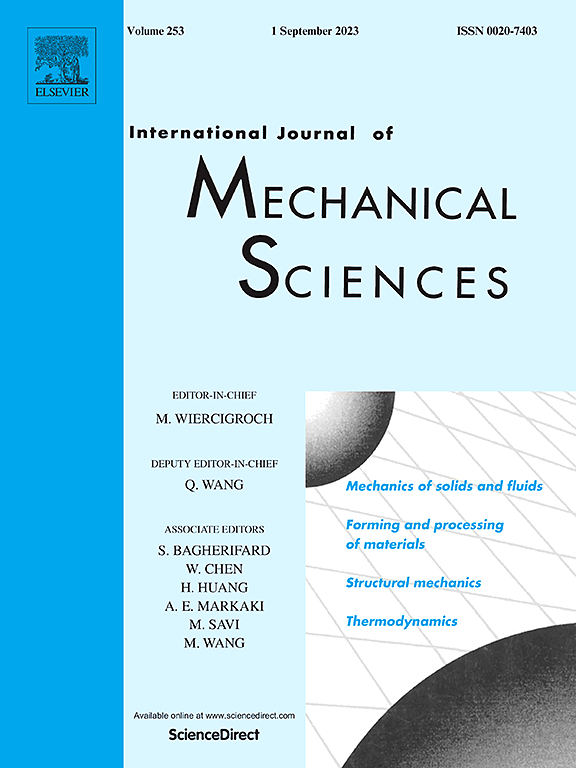The effect of tesla valves on turbine blade tip leakage
IF 7.1
1区 工程技术
Q1 ENGINEERING, MECHANICAL
International Journal of Mechanical Sciences
Pub Date : 2025-07-15
DOI:10.1016/j.ijmecsci.2025.110609
引用次数: 0
Abstract
This paper introduces a novel blade tip design that incorporates the unidirectional flow control technology of Tesla valves, aiming to manage the tip leakage flow in turbines. In this paper, Tesla valves are applied to the tip of a high load turbine blade, and the effectiveness is investigated. This paper analyzes the flow field characteristics, the composition of the vortices, and the loss distribution to understand the working principle of this method. Furthermore, the paper delves into the specific effects of various Tesla valve configurations on the aerodynamic performance of the blade. This study reveals that the unique branching design of Tesla valves creates resistance for the fluid. Due to Tesla valves being machined into the blade tip as grooves, this kind of resistance generates vortices when the leakage flow is obstructed by the grooves. The existence of these vortices disrupts the leakage flow in the upper clearance. Compared to a flat blade tip cascade (Case 1), when Tesla valves are arranged in the crosswise direction (Case 2), perpendicular to the pressure side (Case 3), and in specific orientations aligned with the leakage flow direction (Cases 4–6), the total leakage flow rate is reduced by 4.8 %, 5.9 %, 3.6 %, 5.1 %, and 6.2 % respectively, while the total pressure loss is decreased by 0.7 %, 1.4 %, 4.8 %, 6.8 %, and 8.3 % respectively. Additionally, the paper investigates the effect of the Tesla-valve tip at various incidence angles. The results indicate that Tesla valves effectively reduce the blade tip leakage flow rate and weaken the strength of the tip leakage vortex (TLV) at different incidence angles. The novelty of this study is that this new tip leakage control technology effectively utilizes the unidirectional flow characteristics of the Tesla valve, which has a significant hindrance to the leakage fluid of the turbine tip, reduces the leakage flow rate, and improves the aerodynamic performance of the turbine blade.

特斯拉阀对涡轮叶尖泄漏的影响
本文介绍了一种结合特斯拉阀单向流动控制技术的新型叶尖设计,旨在控制涡轮叶尖泄漏流动。本文将特斯拉阀应用于高负荷涡轮叶片尖端,并对其有效性进行了研究。本文分析了流场特性、涡流组成和损失分布,了解了该方法的工作原理。此外,本文还深入研究了不同特斯拉气门构型对叶片气动性能的具体影响。该研究表明,特斯拉阀门独特的分支设计为流体创造了阻力。由于特斯拉阀是作为沟槽加工到叶尖上的,当泄漏流被沟槽阻挡时,这种阻力会产生涡流。这些涡的存在破坏了上部间隙的泄漏流动。与平叶顶叶栅(案例1)相比,当特斯拉阀沿横向(案例2)、垂直于压力侧(案例3)和与泄漏流动方向一致的特定方向(案例4-6)布置时,总泄漏流量分别降低4.8%、5.9%、3.6%、5.1%和6.2%,总压损失分别降低0.7%、1.4%、4.8%、6.8%和8.3%。此外,本文还研究了不同入射角下特斯拉阀尖端的影响。结果表明,特斯拉阀能有效降低叶尖泄漏流量,并在不同入射角下减弱叶尖泄漏涡强度。本研究的新颖之处在于,这种新的叶尖泄漏控制技术有效地利用了特斯拉阀的单向流动特性,对涡轮叶尖泄漏流体具有明显的阻碍作用,降低了泄漏流量,提高了涡轮叶片的气动性能。
本文章由计算机程序翻译,如有差异,请以英文原文为准。
求助全文
约1分钟内获得全文
求助全文
来源期刊

International Journal of Mechanical Sciences
工程技术-工程:机械
CiteScore
12.80
自引率
17.80%
发文量
769
审稿时长
19 days
期刊介绍:
The International Journal of Mechanical Sciences (IJMS) serves as a global platform for the publication and dissemination of original research that contributes to a deeper scientific understanding of the fundamental disciplines within mechanical, civil, and material engineering.
The primary focus of IJMS is to showcase innovative and ground-breaking work that utilizes analytical and computational modeling techniques, such as Finite Element Method (FEM), Boundary Element Method (BEM), and mesh-free methods, among others. These modeling methods are applied to diverse fields including rigid-body mechanics (e.g., dynamics, vibration, stability), structural mechanics, metal forming, advanced materials (e.g., metals, composites, cellular, smart) behavior and applications, impact mechanics, strain localization, and other nonlinear effects (e.g., large deflections, plasticity, fracture).
Additionally, IJMS covers the realms of fluid mechanics (both external and internal flows), tribology, thermodynamics, and materials processing. These subjects collectively form the core of the journal's content.
In summary, IJMS provides a prestigious platform for researchers to present their original contributions, shedding light on analytical and computational modeling methods in various areas of mechanical engineering, as well as exploring the behavior and application of advanced materials, fluid mechanics, thermodynamics, and materials processing.
 求助内容:
求助内容: 应助结果提醒方式:
应助结果提醒方式:


